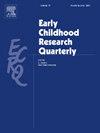Academic impacts of a mindfulness-based intervention on early grades students attending high-needs schools
IF 3.1
1区 教育学
Q1 EDUCATION & EDUCATIONAL RESEARCH
引用次数: 0
Abstract
Academic impacts of school-based mindfulness programs (SBMPs) have been far less studied than social and emotional ones (Roeser et al., 2022), which is surprising considering the intuitive as well as documented ability of mindfulness exercises to train attentional mechanisms. The current study was set up to examine the impact of an SBMP on the executive function, verbal performance, and math performance of a sample of students (n’s = 1,116-1533) in the K-2 grades, relative to a more traditional, social scenarios-based social and emotional learning (SEL) program. 32 Chicago Public Schools were randomly assigned to either the treatment group, which employed the Calm Classroom K-2 program (CCK2; Luster Learning Institute), or the active control group, which employed the district’s default SEL program, Second Step (Committee for Children). The CCK2 group demonstrated advantages in verbal performance after one year of programming (impact estimate = .35 SD) and no other statistically significant program impacts, although any non-trivial differences also favored CCK2 (impact estimates = .05 - .21 SD). Treatment-control differences after two years were smaller, which was contrary to expectations. Exploratory moderation analyses did not reveal any specialized findings within subgroups (e.g., gender, race), or by implementation fidelity. Findings are discussed in terms of the conservative design, implementation challenges in a large-scale program within high-needs public schools, and the different potential mechanisms operating in these programs, making them more complementary than competitive, and suggesting merit in offering non-cognitive activities that employ both “internal” and “external” approaches.
正念干预对高需求学校低年级学生的学术影响
基于学校的正念课程(SBMPs)的学术影响的研究远远少于社会和情感课程(Roeser et al., 2022),考虑到正念练习训练注意力机制的直觉能力和文献记录能力,这一点令人惊讶。目前的研究是为了检验一组K-2年级学生样本(n = 1116 -1533)的SBMP对执行功能、语言表现和数学表现的影响,并与更传统的、基于社会场景的社会和情感学习(SEL)项目进行比较。32所芝加哥公立学校被随机分配到治疗组和积极对照组,前者采用的是平静课堂K-2项目(CCK2; Luster Learning Institute),后者采用的是该地区默认的SEL项目,即第二步(儿童委员会)。CCK2组在一年的编程后表现出语言表现上的优势(影响估计= 0.35 SD),并且没有其他统计上显着的计划影响,尽管任何非微不足道的差异也有利于CCK2(影响估计= 0.05 - 0.21 SD)。两年后治疗与控制的差异变小了,这与预期相反。探索性适度分析没有在亚组(如性别、种族)或实施保真度中揭示任何专门的发现。研究结果从保守的设计、在高需求公立学校的大型项目中实施的挑战、在这些项目中运行的不同潜在机制等方面进行了讨论,这些机制使它们更具互补性而不是竞争性,并提出了采用“内部”和“外部”方法提供非认知活动的优点。
本文章由计算机程序翻译,如有差异,请以英文原文为准。
求助全文
约1分钟内获得全文
求助全文
来源期刊

Early Childhood Research Quarterly
Multiple-
CiteScore
7.00
自引率
8.10%
发文量
109
期刊介绍:
For over twenty years, Early Childhood Research Quarterly (ECRQ) has influenced the field of early childhood education and development through the publication of empirical research that meets the highest standards of scholarly and practical significance. ECRQ publishes predominantly empirical research (quantitative or qualitative methods) on issues of interest to early childhood development, theory, and educational practice (Birth through 8 years of age). The journal also occasionally publishes practitioner and/or policy perspectives, book reviews, and significant reviews of research. As an applied journal, we are interested in work that has social, policy, and educational relevance and implications and work that strengthens links between research and practice.
 求助内容:
求助内容: 应助结果提醒方式:
应助结果提醒方式:


